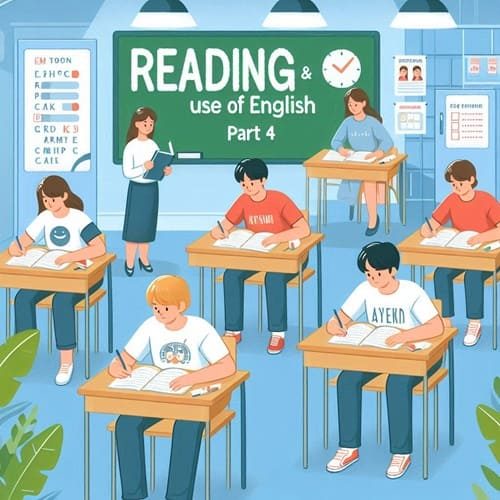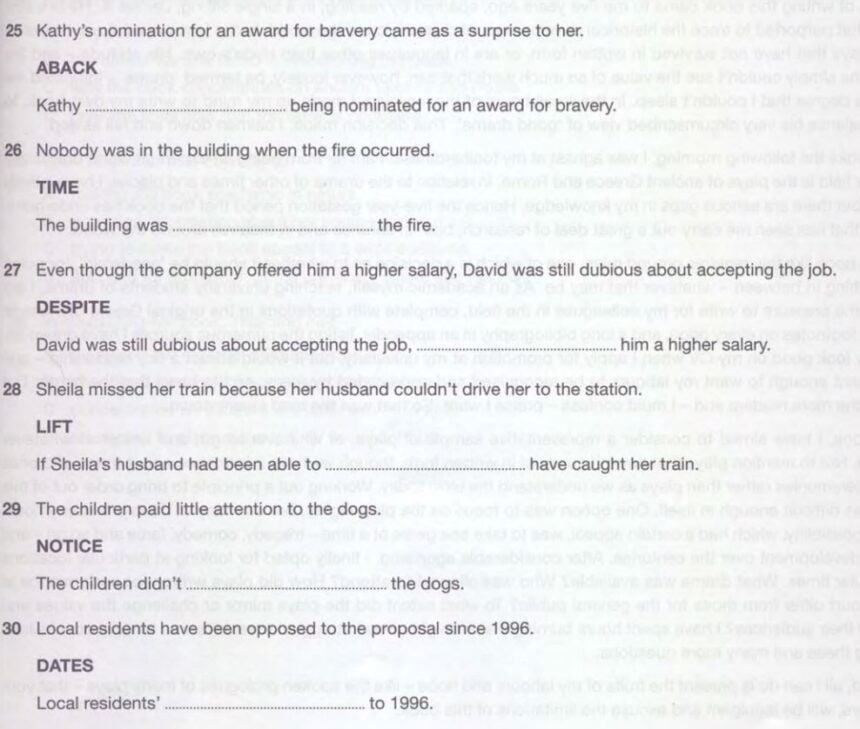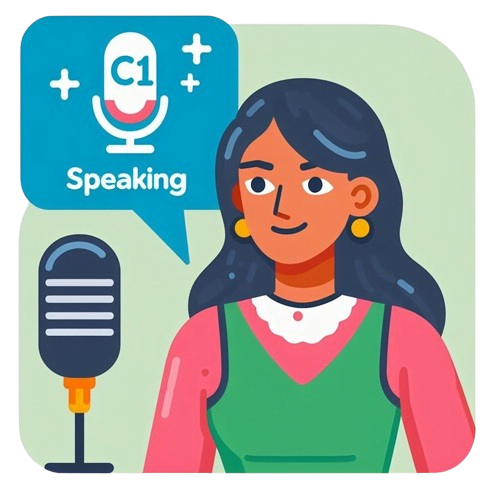Cambridge C1 (CAE): Reading and Use of English Part 4

Key Points
Reading and Use of English (RUE): The RUE paper in the Cambridge C1 Advanced exam consists of 8 parts and takes 90 minutes, testing grammar, vocabulary, and reading comprehension.
Part 4 – Key Word Transformations: This section assesses the ability to express a message differently, using a given key word without changing it, within a three to six-word limit.
Exam Strategy: The article provides a strategy guide for tackling Part 4, emphasizing understanding the general meaning, identifying grammatical differences, and transforming the key word appropriately.
What you will find in this guide:
Reading and Use of English Part 4
As the Cambridge themselves put it, Part 4, consists of six questions. Each question contains three parts: a lead-in sentence, a key word, and a second sentence of which only the beginning and end are given. Candidates have to fill the gap in the second sentence so that the completed sentence is similar in meaning to the lead-in sentence. The gap must be filled with between three and six words, one of which must be the key word. They key word must not be changed in any way.
In this part of the paper the focus is both lexical and grammatical and a range of structures is tested. The ability to express a message in a different way shows flexibility and resource in the use of language. The mark scheme splits the answers into two parts and candidates gain one mark for each part which is correct.
Part 4, the Key Word Transformation, is a critical component that tests not only your vocabulary but also your ability to understand and manipulate language structures.
C1 (CAE) reading and use of English part 4 is not just about knowing words; it’s about understanding their use in context, their nuances, and their synonyms. It’s about flexing your linguistic muscles and showing off your English language finesse.
So, let’s dive into this guide where I’ll share strategies, tips, and resources that will help you conquer this challenging yet rewarding part of the CAE exam. Together, we’ll ensure that you’re well-prepared to tackle these transformations with confidence and ease.
Understanding the Structure of Part 4
As I mentioned in the previous section, the Cambridge C1 (CAE): Reading and Use of English Part 4, is known as Key Word Transformations. This part is where your comprehension skills and vocabulary agility come into play.
Imagine being presented with a sentence, the ‘lead-in’, which conveys a specific idea. Now, picture a second sentence, stripped down to its beginning and end, with a gaping hole in the middle. Your mission? To use a provided ‘key word’ to bridge this gap, crafting a new sentence that echoes the original meaning1. It’s a linguistic challenge that requires precision and creativity.
Each of the six questions in this part demands that you not only understand the given sentences but also manipulate grammatical structures while keeping the essence intact. It’s akin to solving a linguistic equation: the key word is your constant, and you must solve for x without altering the equation’s value.
This task assesses your ability to recognize synonyms, paraphrase effectively, and employ a wide range of grammatical forms. It’s not just about knowing words; it’s about wielding them with skill.
To get a clearer picture of what awaits you in this section, let’s break down an example:
Lead-in sentence: “I started learning English six years ago.” Key word: “for” Second sentence: “I have been ______ English six years.”
Your task is to fill in the blank so that the second sentence means the same as the first, using no more than three words and including the key word ‘for’. The correct answer would be: “I have been learning English for six years.”
Sample Question
Part 4
For questions 25 – 30, complete the second sentence so that it has a similar meaning to the first sentence, using the word given. Do not change the word given. You must use between three and six words, including the word given. Here is an example (0).
Example:
0 James would only speak to the head of department alone.
ON
James ………………………………………..to the head of department alone. The gap can be filled with the words ‘insisted on speaking’, so you write:
INSISTED ON SPEAKING
Write only the missing words IN CAPITAL LETTERS on the separate answer sheet.
25 As long as you explain the process clearly at the conference, your boss will be pleased.
GIVE
If ……………………………………….. the process at the conference, your boss will be pleased.
26 They say that a visitor to the national art gallery damaged an 18th-century painting.
ALLEGED
A visitor to the national art gallery………………………………………… an 18th-century painting.
27 I really don’t mind whether Jill chooses to come on holiday with us or not.
DIFFERENCE
It really…………………………………………whether Jill chooses to come on holiday with us or not.
28 Without the help that Joe gave me, I don’t think I’d have finished the course.
BEEN
If it ……………………………………….. help, I don’t think I’d have finished the course.
29 We can assure our customers that we will take every possible measure to maintain the quality of the products on our shelves.
TAKES
We can assure our customers that we will………………………………………… to maintain the quality of the products on our shelves.
30 Following some complaints by local residents, the government withdrew its proposal to build a new runway at the airport.
LIGHT
The government’s proposal to build a new runway at the airport …………………………………. some complaints by local residents
Potential Challenges
During my career, I have coached and helped many candidates achieve their goals in proficient exams, especially, the CAE. Also, I’ve seen firsthand how Reading and use of English part 4 can be difficult for some candidates. In this part, I will share my experience of working with numerous students to let you know what potential challenges you may face in your exam preparation endeavor. Knowing these challenges can help you prepare better and make sure you will have a plan to overcome them. Here’s a detailed guide on the challenges of CAE reading part 4 to help you manage these challenges:
- You can’t change the sentence’s meaning in any way: Reformulating a sentence is a very delicate task which requires proficiency and attention. It is often the case that when students reformulate their prompt in part 4, their produced sentence carries a slightly different meaning compared to the prompt. This is not acceptable, and can pose a challenge to some candidates.
- Using the right grammar: In speaking, you can express your ideas in any way you wish to. In reading and use of English part 4, however, you have to reformulate the prompt using the presented grammar. This could be challenging for some candidates if they are not familiar with that particular form of grammar.
- I wrote a correct sentence but my answer is wrong! This is often the case because many candidates forget that they have to fulfill the task, not produce a correct sentence.
- You have to write between 3 to 6 words: Limiting your answer to be between 3 to 6 words requires excellent command of English. This may be a bit challenging for some people.
- You can’t change the word given in the prompt: In this part, changing the word given to you in the prompt is not possible. So, if you come up with a sentence transformation that is correct and sounds great but you did that by changing the word given to you in the prompt, your answer will be wrong.
Guide to Part 4
Step 1:
Read the given sentence to comprehend the general meaning of the sentence.
Step 2:
Read the sentence that contains the blanks and the given word. Then, identify the idea that needs to be filled in the blanks.
Step 3:
According to the grammar of the given sentence, and the grammar of the sentence you need to fill in, determine how different both sentences are (in terms of grammar/word structure). In this part you should look for differences such as tense, passive/active, etc.
Step 4:
According to the difference you identified in the last part, transform the given keyword into a suitable phrase that matches the given keyword and write it in the blank in CAPITAL LETTERS.
Step 5:
Make sure your answer is spelled correctly.
Step 6:
Make sure your answer is at least 3 words, it doesn’t exceed 6 words, and that you haven’t changed the word given to you in the prompt.
Practice Test
Use the guide to practice Reading and Use of English part 4 using the following sample test.

References
How was your experience?
Describe your experience taking Reading and Use of English part 4 in the comment section below.







This part was and is pretty difficult for me because I don’t know some phrases that are related to some words like ‘give her a lift’. If I do not know that, it becomes impossible for me to complete the exercise.
However, with the guide provided by the teacher, I was able to improve with some exercises.
In my opinion there are some sentences that are easy for me but in others not because I get confused with the grammar or sometimes I am not sure of my answer. But I will keep in mind the teacher’s tips to improve.
Carolina T
For me, this part is a bit easier because we already have the sentence as a reference. What we need to do is look for other words that refer to the sentence, for example, and they also give us a word that should go. However, the difficulty lies in identifying the correct tense that needs to be used.
For me this part of the exam is difficult because sometimes I do not understand some words in the sentences and as a consequence I do not transform the sentences well. Jimmy.J
This is one of the most difficult parts of Use of English for me because here to be able to make the transformations you need to keep in mind the correct grammar and the word to use. Besides, there is a specific number of words we can use, which makes it difficult for me.